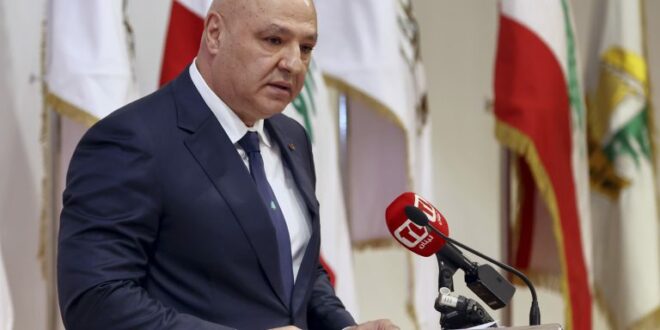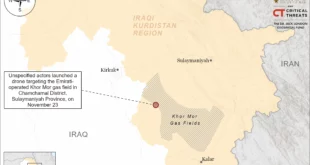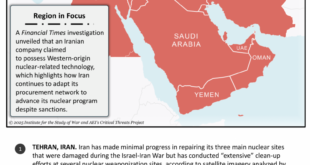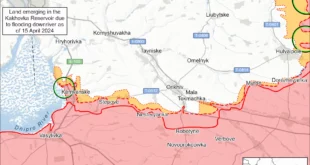Bottom Line Up Front
Trump officials have given Lebanon’s government an ultimatum to take control of Lebanese Hezbollah’s arsenal of heavy weapons or forgo U.S. efforts to compel Israel to withdraw from its positions in southern Lebanon.
U.S. officials expect Lebanon’s cabinet, at a meeting this week, to issue an Executive Order on Hezbollah disarmament that satisfies core U.S. demands without triggering conflict with Hezbollah’s supporters and Lebanese Shia Muslims more broadly.
Hezbollah argues the Lebanese Armed Forces (LAF) does not have the means to secure itself from Israel if the group’s militia dissolves, a public position that masks the group’s intent to remain a key political and military force within the country.
The U.S.-Lebanon plan relies on providing the Lebanese Armed Forces (LAF) with substantial funding to rearm, reform, and expand its ranks.
Trump’s foreign policy team seeks to translate a November Israel-Lebanon ceasefire, which affirmed Hezbollah’s severely weakened state, into a permanent regional balance of power shift toward the U.S. and Israel and away from Iran. Israel not only seeks to further weaken Iran’s coalition but also to ensure that Hezbollah, as well as Palestinian militant groups, pose no further threat to its northern border. To advance these goals, U.S. officials have given Lebanon’s government an ultimatum to demand that Hezbollah turn over the core of its arsenal to the Lebanese Armed Forces (LAF) or forgo U.S. help persuading Israel to end its military operations inside Lebanon. Neither the U.S. nor Israel is demanding that Hezbollah dissolve as a political movement or dismantle its extensive social services infrastructure that provides food and other sustenance to many poor Lebanese Shia Muslims. Hezbollah and its political allies hold 13 seats in Lebanon’s 128-seat parliament and typically hold two or three cabinet positions in Lebanon’s government as well.
The November 2024 Israel-Lebanon ceasefire that ended the post-October 7, 2023 conflict between Israel and Hezbollah sought to implement U.N. Security Council Resolution 1701, which ended a 2006 Israel-Hezbollah conflict. The Resolution, as clarified and reinforced by the 2024 ceasefire accord, requires both Israel and Hezbollah to withdraw from southern Lebanon fully. Currently, Hezbollah no longer holds positions south of the Litani River, as required, but Israel – seeking to weaken the group further – has maintained control of five commanding heights in south Lebanon (“the five points”). Israel also continues to strike Hezbollah’s remaining arsenal wherever positioned throughout Lebanon, including with a significant barrage of air strikes last week. The 2024 ceasefire agreement, as did 1701, nonetheless left vague how Hezbollah’s weapons and military facilities north of the Litani River should be treated. The 2024 ceasefire text states: “Starting with the Southern Litani Area, (the government of Lebanon will) dismantle all existing unauthorized facilities involved in the production of arms and related materiel, and prevent the establishment of such facilities in the future.” The text further reads: “Starting with the Southern Litani Area, (Lebanon’s government will) dismantle all infrastructure and military positions, and confiscate all unauthorized arms inconsistent with these commitments.”
Hezbollah maintains that the requirement to disarm applies only south of the Litani River, while Israel and the U.S. say it mandates disarmament of the group’s military assets throughout Lebanon. Lebanon’s political leaders, including President Joseph Aoun, a Maronite Christian leader who was LAF commander before assuming his position earlier in 2025, recognize that enforcing the Israeli and U.S. interpretation might return Lebanon to a level of civil conflict it has not seen in decades. But, in part to retain U.S. backing, Aoun – whose election in January was made possible in part by the shifting balance of power in the wake of the Israel-Hezbollah conflict – last week reiterated his call for Hezbollah to hand over its weapons to the LAF. In a televised speech in Defense Ministry headquarters on Thursday, Aoun stated: “It is the duty of all political parties… to seize this historic opportunity without hesitation and push for the exclusivity of weapons in the hands of the army and security forces and no one else.”
Hezbollah’s leader, Secretary-General Naim Qassem, whom Hezbollah’s Shura Council selected to succeed Hassan Nasrallah in October 2024 after his death, reiterated his rejection of the group’s disarmament outright. Arguing that Hezbollah disarmament would render Lebanon defenseless against Israel, Qassem stated on Wednesday: “Those who call for submitting arms practically demand submitting them to Israel…We will not submit to Israel.” At the same time, most experts assess Hezbollah’s public arguments against disarming reflect the group’s position to remain a potent military and political force in Lebanon – a goal that comports with the interests of leaders in Tehran as well.
The internal dispute over the fate of Hezbollah’s military wing is escalating as Trump’s team pressures the Lebanese government to move forward to assert its monopoly on the fielding of armed forces within the country. In mid-July, Trump’s Ambassador to Türkiye, Tom Barrack, who also serves as U.S. envoy on Syria and Lebanon, presented Lebanese officials with an ultimatum to issue an Executive Order requiring Hezbollah to submit its weapons to the LAF. Barrack warned Beirut that it otherwise risks U.S. diplomatic support to compel Israel to withdraw fully from South Lebanon. Aoun’s government reportedly countered the U.S. demand with a seven-page document that stopped short of agreeing to disarm Hezbollah nationwide – reflecting Beirut’s concerns that adopting the U.S. position risks renewed civil conflict with a determined and still lethal Hezbollah that commands the support of most Lebanese Shias. Barrack responded to Beirut’s counteroffer by saying: “I thought it was responsive, very responsive,” while acknowledging that “sticking points” remain.
A meeting of Lebanon’s Council of Ministers (cabinet) meeting, planned for Tuesday, is expected to decide on a finalized text of the Executive Order on Hezbollah disarmament. It is possible the final Order will incorporate compromise language that Barrack has suggested might be acceptable to Washington. Barrack has told journalists the U.S. might accept an Order that requires Hezbollah to voluntarily hand over only heavy weapons, including rockets and drones, to monitored depots under a “mechanism” involving the U.S., France, Israel and the LAF. The reported compromise formulation suggests Washington will not require Hezbollah to submit its lighter weaponry to the LAF or disband its military wing outright.
Washington’s flexibility and apparent deference to Beirut reflect the widely acknowledged weaknesses of the LAF not only to defend all of Lebanon’s territory but also to withstand an armed challenge by Hezbollah, should the group forcibly resist ceding any of its arsenal or facilities. Barrack told journalists in mid-July: “We don’t have the soldiers on the ground for the LAF to be able to do that (disarm Hezbollah) yet, because they don’t have the money. They’re using equipment that’s 60 years old.” He added that, although the LAF is the “best, neutral, reliable mediator” in the current crisis, it operates “on a shoestring budget,” forcing U.N. peacekeepers in Lebanon, UNIFIL (U.N. Interim Force in Lebanon), to fill the gap with 10,000 troops.”
U.S. officials have sought to stiffen Aoun’s resolve against Hezbollah by promising to fulfill the conditions necessary for the LAF to become fully manned, equipped, and combat-effective. When it meets this week to try to finalize the disarmament Executive Order, Lebanon’s cabinet is expected to include a call for international donors to contribute $1 billion annually for 10 years to augment the LAF capabilities and for an international donor conference to fund reconstruction of Lebanese areas damaged and destroyed during last year’s war, the Israel-Hezbollah war. Barrack has indicated the U.S. is seeking funding from the Arab Gulf states, but has faced some opposition. He said in mid-July: “We want money to go to the LAF…Why do the Gulf partners not want to do that? Because they’ve given so much money to Lebanon in the past, that’s gone to the corrupt leaders. So they’re saying, ‘Yeah, we’re done.’” But, expressing the U.S. intent to continue seeking help from the Gulf states and other sources, Barrack noted: “We need to help bolster the LAF…We can do it hand-in-hand with the Gulf countries, hand-in-hand with UNIFIL, as we redefine what their role is on a continued basis.”
U.S. officials also have offered to work directly with the LAF. Last week, U.S. Central Command leader General Michael Kurilla, accompanied by a U.S. military delegation, met with Aoun at his presidential palace. A statement from Aoun’s presidential office said the talks covered “the ongoing cooperation between the Lebanese Army and the U.S. Army and means to develop it in all fields…” The readout added Aoun and Kurilla discussed “President Aoun’s firm stances on the monopolization of arms and the domestic and foreign responses to them,” and the “need for boosting U.S. support for the Lebanese Army, which alone reflects the will of the Lebanese to see their country free, sovereign and independent.” The Kurilla meeting with Aoun seemed intended to send a clear signal to Hezbollah – and to Tehran – that Trump stands behind Beirut should Hezbollah seek to resist the anticipated Executive Order. However, many experts question whether, should Lebanon fulfill its commitments to the U.S., the Trump team will be able to implement its pledge to prevail on Israeli Prime Minister Benjamin Netanyahu to withdraw his forces from the commanding heights they occupy in south Lebanon.
 Eurasia Press & News
Eurasia Press & News



